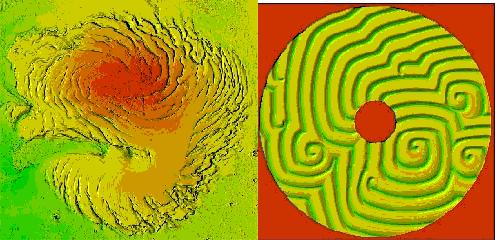(University of Arizona News) By: Mari N. Jensen Translated by: Eli Ben

Right: A relief-shaded simulation of the Arctic ice caps - courtesy of Jon Pelletier. On the left - the strange shapes as photographed from orbit around Mars
Direct link to this page: https://www.hayadan.org.il/mars_polar_spiral.html
The spiral trenches of the polar ice cap of Mars have been called the most mysterious landforms in the entire solar system. The deep winding canyons on the Red Planet at the North and South Poles cover hundreds of miles. There is no planet in the solar system with such a soil pattern.
A new model of channel formation theorizes that heating and cooling alone were effective enough to create the unusual patterns. Previous explanations focused around the cycle of thawing and refreezing which also required wind to move the domes.
"I asked for certain parameters that were suitable for Mars and from that came spirals that were not only spirals, but ones that had an exact resemblance to the shapes we see on Mars." said Jon Pelletier, assistant professor of geosciences at the University of Arizona in Tucson. "They had the right intervals, they had the right curvature (arching), and there was a mutual affinity between them."
His report, "How do spiral canals form in March?" It was published in the April edition of the scientific journal the journal Geology. One of his computer simulations graces the cover of the newspaper.
How exactly the ice canyons were formed in a spiral pattern has been a question that has puzzled scientists since the pattern was discovered by the "Viking" in 1976.
Peltier, a geomorphologist who studies terrestrial landforms such as sand dunes and river courses, has a particular weakness for natural patterns that are regularly spaced.
Spirals, then, are suitable for research, because while reading a book on mathematical patterns in biology, he was struck by the enlightenment about the spiral shape created in the mud model. He wondered if the mathematical equations describing the formation of the mud model could also apply to a geological process.
"There is a recipe for creating spirals" he said. So he tried it, using the information that described the situation on Mars.
For most of the year, the Martian climate is in a state of constant freezing. For short periods of time during the summer, the temperature in the polar ice caps rises to the extent sufficient to break the ice to a small extent - says Peltier.
He suggests, ifa, that during this time, cracks and crevices in the face of the ice facing steeply toward the sun may partially melt, while deepening and widening the cracks. A wall of the sun may also spread through the ice.
Due to the low air pressure, unlike on Earth, on Mars the melting ice simply evaporates and evaporates instead of turning into liquid water. The water vapor, when it hits the cold, shaded side of a small canyon, condenses and refreezes, so that the canyon widens and deepens because one side of it warms at times while the other side remains cold. "The temperatures surrounding Mars are just enough to create the pattern. And this is not true anywhere else in the solar system", he says, "the spirals are created because the melting of the ice is focused in a certain place".
Peltier claims that the thawing and refreezing variable is the key to the formation of the spiral canals on Mars. So he put mathematical descriptions of the heating and cooling cycle into a spiral generator equation and ran them through the computer simulations to predict what would happen in thousands of such cycles. He did not include wind or movements of the polar ice caps in his model. The computer created patterns that matched what was seen on Mars, even down to the imperfections of the spirals.
"The model I created experiences the spaces between these things, how they curve, and how they develop over time to create the characterization of the spiral" he said.
"Many planetary sciences are based on educated guesses about images we see. We cannot go there and conduct field experiments", he said. "The development of numerical models provides us with a multi-weighted means of what we need to create the pattern we see, and allow scientists to test their assumptions," he said.
The visualization created by Peltier's computer simulation shows patterns like those of the spiral canals of Mars down to the precision of imperfections.
For information on the University of Arizona website
Ydan Mars
https://www.hayadan.org.il/BuildaGate4/general2/data_card.php?Cat=~~~801557650~~~16&SiteName=hayadan
